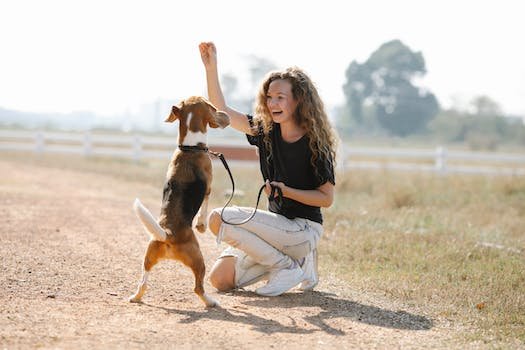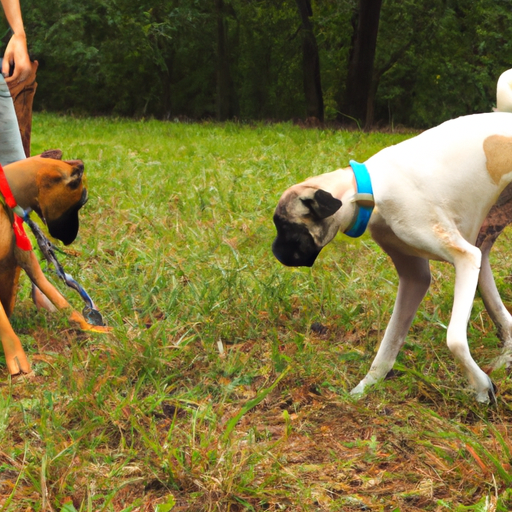Understanding the Causes of Leash Reactivity in Aggressive Dogs
Generate a list of relevant keywords for a website or blog post using Google Keyword Planner
Dealing with Leash Reactivity: Training Aggressive Dogs
Understanding the Causes of Leash Reactivity in Aggressive Dogs
Aggression in dogs can be a challenging issue for pet owners to deal with. One common manifestation of aggression is leash reactivity, where a dog becomes aggressive or reactive when on a leash. This behavior can be distressing for both the dog and the owner, and it is important to understand the underlying causes in order to effectively address the problem.
Leash reactivity can stem from a variety of factors, including fear, frustration, and a lack of socialization. Dogs that have had negative experiences while on a leash, such as being attacked by another dog or being punished for pulling, may develop a fear response. This fear can then manifest as aggression when the dog feels trapped or threatened while on a leash.
Frustration can also contribute to leash reactivity. Dogs that are not given enough physical or mental stimulation may become bored and frustrated, leading to reactive behavior. Additionally, dogs that have not been properly socialized may not know how to appropriately interact with other dogs or people, causing them to react aggressively when on a leash.
It is important to note that leash reactivity is not always a sign of an inherently aggressive dog. Many dogs that display leash reactivity are actually fearful or anxious, and their aggression is a defensive response. Understanding this distinction is crucial in order to approach training and behavior modification in the most effective way.
When dealing with leash reactivity, it is important to consult with a professional dog trainer or behaviorist who specializes in aggression. They will be able to assess the specific triggers and underlying causes of the reactivity and develop a tailored training plan.
One common approach to addressing leash reactivity is desensitization and counterconditioning. This involves gradually exposing the dog to the triggers that cause the reactivity, while simultaneously providing positive reinforcement for calm behavior. For example, if a dog becomes reactive when seeing another dog, the trainer may start by having the dog observe the other dog from a distance and reward them for remaining calm. Over time, the distance is gradually decreased until the dog can be in close proximity to other dogs without reacting aggressively.
In addition to desensitization and counterconditioning, it is important to work on basic obedience training with a reactive dog. Teaching them commands such as “sit,” “stay,” and “leave it” can help redirect their focus and provide them with an alternative behavior to engage in when they feel anxious or threatened.
It is also important for owners to manage their dog’s environment to prevent situations that may trigger reactivity. This may involve avoiding crowded areas or using a muzzle when in public spaces. By setting the dog up for success and minimizing their exposure to triggers, owners can help reduce the likelihood of reactive behavior.
In conclusion, leash reactivity in aggressive dogs can be a complex issue with multiple underlying causes. Understanding these causes, such as fear, frustration, and lack of socialization, is crucial in order to effectively address the problem. Working with a professional trainer or behaviorist and implementing techniques such as desensitization and counterconditioning can help modify the dog’s behavior and improve their overall quality of life. With patience, consistency, and proper training, leash reactivity can be managed and even overcome.
Effective Training Techniques for Managing Leash Reactivity in Aggressive Dogs

Dealing with Leash Reactivity: Training Aggressive Dogs
Leash reactivity is a common issue faced by many dog owners. It can be a challenging and frustrating problem to deal with, but with the right training techniques, it is possible to manage and improve the behavior of aggressive dogs on a leash. In this article, we will discuss some effective training techniques that can help you address leash reactivity in your dog.
One important aspect of training aggressive dogs is understanding the underlying causes of their behavior. Leash reactivity can stem from fear, anxiety, or a lack of socialization. By identifying the root cause, you can tailor your training approach to address the specific needs of your dog.
Positive reinforcement is a key component of training aggressive dogs. This involves rewarding your dog for calm and appropriate behavior. When your dog remains calm and focused while on a leash, offer treats, praise, or a favorite toy as a reward. This positive reinforcement helps to reinforce the desired behavior and encourages your dog to repeat it in the future.
Counter-conditioning is another effective technique for managing leash reactivity. This involves changing your dog’s emotional response to the triggers that cause their reactive behavior. Start by exposing your dog to the trigger at a distance where they remain calm and relaxed. Gradually decrease the distance over time, always ensuring that your dog remains calm and focused. Pair the exposure to the trigger with positive reinforcement, such as treats or praise. This helps your dog associate the trigger with positive experiences, gradually reducing their reactivity.
Desensitization is closely related to counter-conditioning and involves gradually exposing your dog to the trigger in a controlled and systematic manner. Start by exposing your dog to a low-intensity version of the trigger, such as a distant dog or a person walking by. As your dog becomes more comfortable, gradually increase the intensity of the trigger, such as having a dog walk closer or a person approach. The key is to progress at a pace that allows your dog to remain calm and focused, always pairing the exposure with positive reinforcement.
It is important to remain calm and patient throughout the training process. Aggressive dogs can sense your emotions, and if you become anxious or frustrated, it can escalate their reactivity. Take breaks when needed and always end training sessions on a positive note. Consistency is also crucial. Establish a routine and stick to it, ensuring that everyone in the household follows the same training techniques and rules.
In addition to training techniques, there are some practical steps you can take to manage leash reactivity. Using a front-clip harness or head halter can provide better control and prevent your dog from pulling or lunging. Avoiding crowded areas or busy times of the day can also help reduce triggers and minimize your dog’s reactivity.
Seeking professional help from a certified dog trainer or behaviorist is highly recommended, especially if your dog’s reactivity is severe or if you are unsure about how to proceed with training. They can provide guidance, support, and additional training techniques tailored to your dog’s specific needs.
In conclusion, managing leash reactivity in aggressive dogs requires a combination of understanding, patience, and effective training techniques. By identifying the underlying causes, using positive reinforcement, and implementing counter-conditioning and desensitization, you can help your dog overcome their reactivity and improve their behavior on a leash. Remember to remain calm, consistent, and seek professional help when needed. With time and dedication, you can successfully train your aggressive dog to become a well-behaved and happy companion.
Tips for Maintaining a Positive and Safe Walking Experience with Leash Reactive Dogs
Dealing with Leash Reactivity: Training Aggressive Dogs
Walking your dog should be an enjoyable experience for both you and your furry friend. However, if you have a leash reactive dog, it can quickly turn into a stressful and potentially dangerous situation. Leash reactivity is a common issue among dogs, and it can manifest as barking, lunging, or growling at other dogs or people while on a leash. Fortunately, with the right training and techniques, you can help your aggressive dog become more comfortable and relaxed during walks.
One of the first steps in dealing with leash reactivity is to understand the underlying causes. Leash reactivity can stem from fear, anxiety, or a lack of socialization. It is important to remember that leash reactive dogs are not necessarily aggressive by nature, but rather, they are reacting out of fear or discomfort. By identifying the triggers that cause your dog to react, you can begin to address the issue more effectively.
When walking your leash reactive dog, it is crucial to remain calm and composed. Dogs are highly perceptive animals and can pick up on your emotions. If you become anxious or tense, your dog is likely to mirror those feelings, which can escalate their reactivity. Instead, practice deep breathing and maintain a relaxed posture. This will help to create a more positive and calm environment for your dog.
Another important aspect of training leash reactive dogs is to use positive reinforcement techniques. Punishment or harsh corrections can exacerbate your dog’s reactivity and may even lead to aggression. Instead, reward your dog for calm behavior and for focusing on you during walks. Treats, praise, and toys can be used as rewards to reinforce positive behavior. By associating good behavior with positive outcomes, your dog will be more motivated to remain calm and focused.
In addition to positive reinforcement, desensitization and counterconditioning techniques can be highly effective in reducing leash reactivity. Desensitization involves gradually exposing your dog to their triggers at a distance that does not elicit a reactive response. For example, if your dog reacts to other dogs, start by walking them at a distance where they can see the other dogs but remain calm. Over time, gradually decrease the distance between your dog and the trigger, always rewarding calm behavior. Counterconditioning involves changing your dog’s emotional response to their triggers by pairing them with positive experiences. For instance, if your dog reacts to bicycles, you can start by having someone ride a bicycle at a distance while you give your dog treats or play a game. This will help your dog associate bicycles with positive experiences, gradually reducing their reactivity.
Consistency is key when training leash reactive dogs. Establish a routine and stick to it. Regular walks and training sessions will help your dog become more comfortable and confident over time. It is also important to manage your dog’s environment to avoid unnecessary triggers. For example, if your dog reacts to other dogs, try walking them during quieter times or in less crowded areas. This will help to minimize their exposure to potential triggers and reduce their reactivity.
Dealing with leash reactivity can be challenging, but with patience, consistency, and positive reinforcement, you can help your aggressive dog become more comfortable and relaxed during walks. Remember to remain calm and composed, use positive reinforcement techniques, and gradually expose your dog to their triggers while rewarding calm behavior. By implementing these strategies, you can create a positive and safe walking experience for both you and your leash reactive dog.
